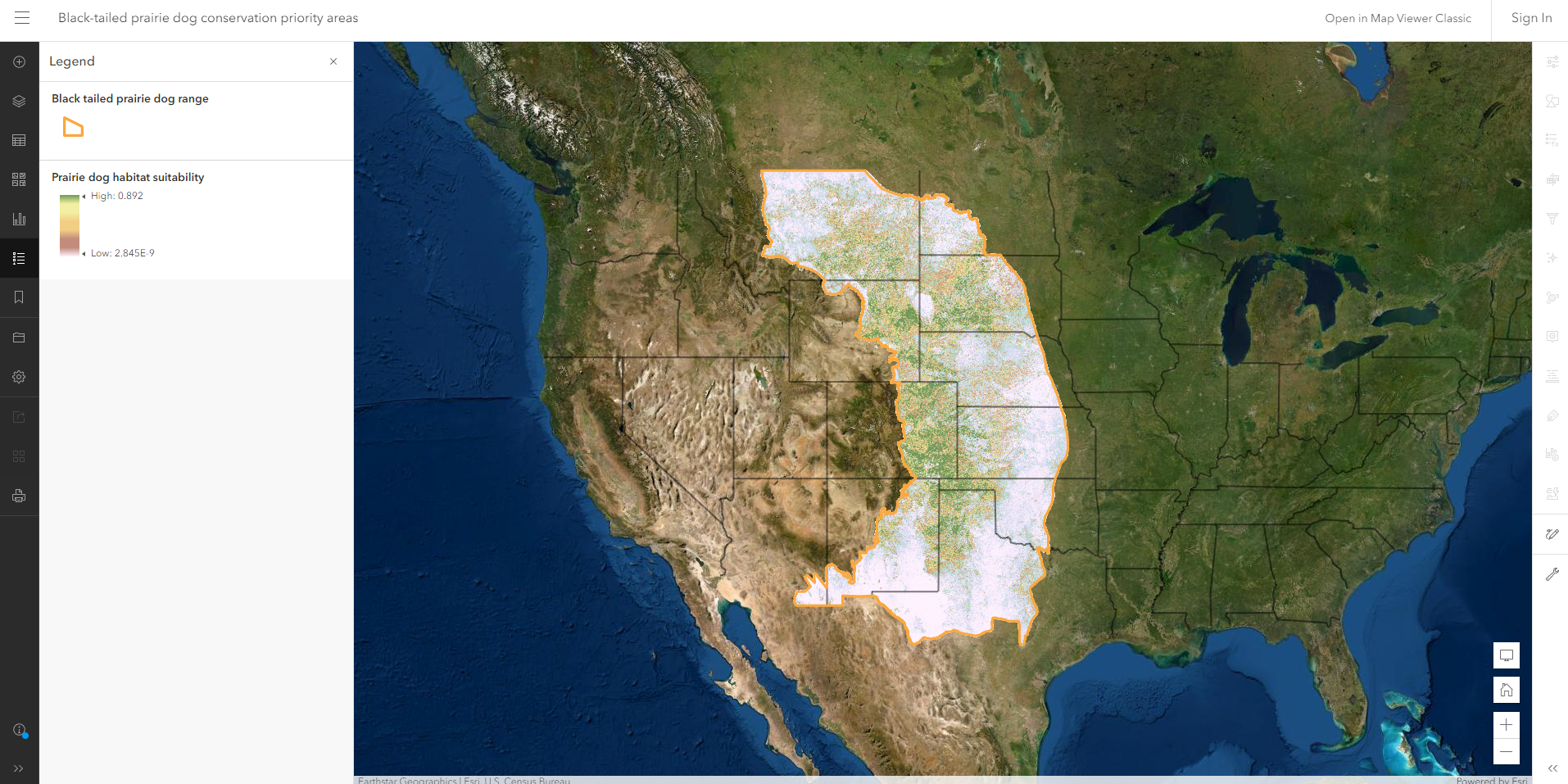HOMES ON THE RANGE
Our team has developed a large-scale collaborative conservation planning initiative for the black-tailed prairie dog (BTPD) ecosystem that stretches across North America’s central grasslands. Because prairie dogs are keystone species (Fig. 1), their conservation and management often lies at the core of grassland conservation efforts. Through spatial modelling, we have identified potential landscapes for prairie dog ecosystem conservation that consider ecological, political, and social factors, along with changing climate and land use to maximize long-term conservation potential and co-existence with human activities. Our project results and data available for download, below, include two components: 1) a BTPD habitat suitability model under both current climate and projected future climate and 2) priority landscapes for BTPD ecosystem conservation across the range of BTPDs within the United States.

Methods
Our HSM is based on presence and absence data for prairie dog occurrences across the geographic range of the BTPD within the United States, and how the prairie dog occurrences relate to climate, soils, topography, and land cover (Fig. 2). We also project the BTPD HSM under two future climate scenarios: 1) warm and wet and 2) hot and dry.

Table 1. Spatial Data Layers and their Sources used in the Black-tailed Prairie Dog (BTPD) Habitat Suitability Model.


Results
Our final ensemble model exhibited high predictive accuracy, with an AUC of 0.96 and error rate of 13% at a Sensitivity (ability to correctly identify prairie dog habitat) of 95% (Fig. 3). The most suitable habitat for the BTPD ecosystem under the current climate extends largely from northern and eastern New Mexico and the panhandle of Texas and Oklahoma through eastern Colorado, eastern Wyoming, southern Montana, western south Dakota, and parts of western Kansas and Nebraska (Fig. 4). Small patches of suitable habitat occur through the southwest in Arizona, southern New Mexico, and southwest Texas. The eastern part of the original prairie dog range is largely unsuitable due to the extensive conversion of grassland to cropland, and the southern portion of their geographic range is limited largely by climate suitability. Low suitability across most of Nebraska is due to excessively sandy soils. Projecting suitable habitat into the future under both future scenarios (warm and wet; hot and dry) shows how the suitable habitat shifts northward.
| State Name | Low | Medium | High |
|---|---|---|---|
| Montana | 1,763,366 | 1,345,433 | 1,588,702 |
| North Dakota | 340,733 | 180,275 | 63,826 |
| South Dakota | 1,711,314 | 1,277,664 | 1,470,485 |
| Wyoming | 1,064,272 | 1,021,180 | 1,961,438 |
| Nebraska | 692,534 | 441,174 | 389,552 |
| Colorado | 1,338,636 | 1,558,562 | 4,216,600 |
| Kansas | 631,120 | 420,207 | 760,199 |
| Arizona | 13,750 | 5,789 | 108 |
| Oklahoma | 280,290 | 212,791 | 480,503 |
| Texas | 1,018,266 | 804,629 | 1,064,014 |
| New Mexico | 1,169,982 | 863,150 | 728,047 |
| Entire US Range | 10,024,502 | 8,130,936 | 12,723,491 |
Methods
Here, we use a conservation planning analysis to identify potential landscapes for conservation across North America’s central grasslands, with a focus on the BTPD ecosystem within the United States (Fig. 5). The goal of this analysis was to not only assess the suitability of the habitat for the prairie dog ecosystem, but also how the social and political landscape, threats to prairie dog habitat (e.g., development), habitat connectivity, and general ecological landscape (e.g., percent cover of grass) collectively influence opportunities to conserve the BTPD ecosystem. We selected potential landscapes for prairie dog ecosystem conservation using the spatial conservation prioritization method and Zonation software.
Results
Our results show that potential landscapes for BTPD ecosystem conservation are largely found across the western portion of the current/historical range, and the priorities under current climate across the Southwest largely disappear under both future climate scenarios (Fig. 6). The areas with highest conservation priority are represented in red and pink. These areas primarily reflect high habitat connectivity, highly suitable habitat, and low threats. Very northeastern New Mexico, eastern Colorado, eastern Wyoming, eastern Montana, very eastern Nebraska, and western South Dakota harbor the greatest amount of priority habitat now and into the future. Much of (but not all) the high priority habitat in Arizona, southern New Mexico, and Texas under today’s climate does not maintain such status under the future climate scenarios.


As conservation policies and funding decisions are usually made by political entities, we also selected conservation priorities considering the state boundaries, so that priorities are identified within each state. The priorities change dramatically when we look by state, instead of across the entire BTPD range; this is to be expected because we are specifically modelling for priority habitat within each state (Fig. 7). We did this because funding sources and conservation priorities are often at the state-level, and not range-wide. This way, each state has information on conservation priorities within their own jurisdictional boundaries. In these state-based scenarios, much of the high priority habitats in Arizona, New Mexico, and Texas remain high priority under the future climate scenarios. Using the state-based scenarios, we identified 26,935,416 ha (16%) that represent high conservation priority under current and projected future climates (Fig. 7).



















